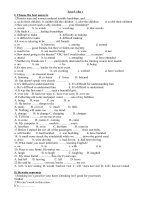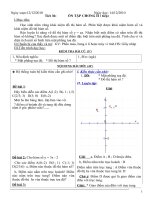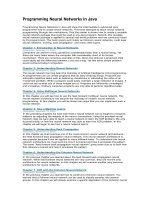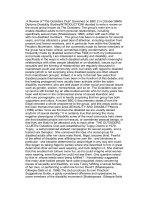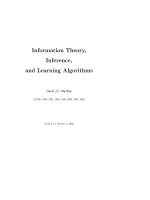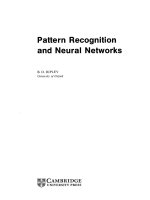programming neural networks with encog 2 in java
Bạn đang xem bản rút gọn của tài liệu. Xem và tải ngay bản đầy đủ của tài liệu tại đây (3.6 MB, 481 trang )
!"#$%&'()*+, )*%&./0,1",2"),+&3)%&45)*,
This%book%is%copyrighted%by%Heaton%Research,%Inc.%%If%you % obtained%this%
book%from%a%source%other%than%Heaton%Research%please%contact%us%at%
%
%
6""7,8&)/*,
Programming%Neural%Network%s%with%%
Encog%2%in%Java%
9:6;,
1604390077%–%Rev%1%(March%2010)%
<5)("%,
Jeff%Heaton%
=>6""7,?%&@*,
$19.99%(USD)%
%
%
%
%
Programming Neural Networks
with Encog 2 in Java
Programming Neural Networks
with Encog 2 in Java
By Jeff Heaton
Heaton Research, Inc.
St. Louis, MO USA
vi
Programming Neural Networks with Encog 2 in Java
Publisher: Heaton Research, Inc
Programming Neural Networks with Encog 2 in Java
March, 2010
Author: Jeff Heaton
Editor: WordsRU.com
Cover Art: Carrie Spear
ISBN’s for all Editions:
1-60439-007-7, Softcover
1-60439-011-5, Adobe PDF e-book
Copyright © 2010 by Heaton Research Inc., 1734 Clarkson Rd. #107,
Chesterfield, MO 63017-4976. World rights reserved. The author(s)
created reusable code in this publication expressly for reuse by
readers. Heaton Research, Inc. grants readers permission to reuse
the code found in this publication or downloaded from our website
so long as (author(s)) are attributed in any application
containing the reusable code and the source code itself is never
redistributed, posted online by electronic transmission, sold or
commercially exploited as a stand-alone product. Aside from this
specific exception concerning reusable code, no part of this
publication may be stored in a retrieval system, transmitted, or
reproduced in any way, including, but not limited to photo copy,
photograph, magnetic, or other record, without prior agreement
and written permission of the publisher.
Heaton Research, Encog, the Encog Logo and the Heaton Research
logo are all trademarks of Heaton Research, Inc., in the United
States and/or other countries.
TRADEMARKS: Heaton Research has attempted through out this book
to distinguish proprietary trademarks from descriptive terms by
following the capitalization style used by the manufacturer.
The author and publisher have made their best efforts to prepare
this book, so the content is based upon the final release of
software whenever possible. Portions of the manuscript may be
based upon pre-release versions suppled by software
manufacturer(s). The author and the publisher make no
representation or warranties of any kind with regard to the
completeness or accuracy of the contents herein and accept no
liability of any kind including but not limited to performance,
vii
merchantability, fitness for any particular purpose, or any
losses or damages of any kind caused or alleged to be caused
directly or indirectly from this book.
Manufactured in the United States of America.
SOFTWARE LICENSE AGREEMENT: TERMS AND CONDITIONS
The media and/or any online materials accompanying this book that
are available now or in the future contain programs and/or text
files (the “Software”) to be used in connection with the book.
Heaton Research, Inc. hereby grants to you a license to use and
distribute software programs that make use of the compiled binary
form of this book’s source code. You may not redistribute the
source code contained in this book, without the written
permission of Heaton Research, Inc. Your purchase, acceptance,
or use of the Software will constitute your acceptance of such
terms.
The Software compilation is the property of Heaton Research, Inc.
unless otherwise indicated and is protected by copyright to
Heaton Research, Inc. or other copyright owner(s) as indicated in
the media files (the “Owner(s)”). You are hereby granted a
license to use and distribute the Software for your personal,
noncommercial use only. You may not reproduce, sell, distribute,
publish, circulate, or commercially exploit the Software, or any
portion thereof, without the written consent of Heaton Research,
Inc. and the specific copyright owner(s) of any component
software included on this media.
In the event that the Software or components include specific
license requirements or end-user agreements, statements of
condition, disclaimers, limitations or warranties (“End-User
License”), those End-User Licenses supersede the terms and
conditions herein as to that particular Software component. Your
purchase, acceptance, or use of the Software will constitute your
acceptance of such End-User Licenses.
By purchase, use or acceptance of the Software you further agree
to comply with all export laws and regulations of the United
States as such laws and regulations may exist from time to time.
viii
Programming Neural Networks with Encog 2 in Java
SOFTWARE SUPPORT
Components of the supplemental Software and any offers associated
with them may be supported by the specific Owner(s) of that
material but they are not supported by Heaton Research, Inc
Information regarding any available support may be obtained from
the Owner(s) using the information provided in the appropriate
README files or listed elsewhere on the media.
Should the manufacturer(s) or other Owner(s) cease to offer
support or decline to honor any offer, Heaton Research, Inc.
bears no responsibility. This notice concerning support for the
Software is provided for your information only. Heaton Research,
Inc. is not the agent or principal of the Owner(s), and Heaton
Research, Inc. is in no way responsible for providing any support
for the Software, nor is it liable or responsible for any support
provided, or not provided, by the Owner(s).
WARRANTY
Heaton Research, Inc. warrants the enclosed media to be free of
physical defects for a period of ninety (90) days after purchase.
The Software is not available from Heaton Research, Inc. in any
other form or media than that enclosed herein or posted to
www.heatonresearch.com. If you discover a defect in the media
during this warranty period, you may obtain a replacement of
identical format at no charge by sending the defective media,
postage prepaid, with proof of purchase to:
Heaton Research, Inc.
Customer Support Department
1734 Clarkson Rd #107
Chesterfield, MO 63017-4976
Web: www.heatonresearch.com
E-Mail:
DISCLAIMER
Heaton Research, Inc. makes no warranty or representation, either
expressed or implied, with respect to the Software or its
ix
contents, quality, performance, merchantability, or fitness for a
particular purpose. In no event will Heaton Research, Inc., its
distributors, or dealers be liable to you or any other party for
direct, indirect, special, incidental, consequential, or other
damages arising out of the use of or inability to use the
Software or its contents even if advised of the possibility of
such damage. In the event that the Software includes an online
update feature, Heaton Research, Inc. further disclaims any
obligation to provide this feature for any specific duration
other than the initial posting.
The exclusion of implied warranties is not permitted by some
states. Therefore, the above exclusion may not apply to you. This
warranty provides you with specific legal rights; there may be
other rights that you may have that vary from state to state. The
pricing of the book with the Software by Heaton Research, Inc.
reflects the allocation of risk and limitations on liability
contained in this agreement of Terms and Conditions.
SHAREWARE DISTRIBUTION
This Software may use various programs and libraries that are
distributed as shareware. Copyright laws apply to both shareware
and ordinary commercial software, and the copyright Owner(s)
retains all rights. If you try a shareware program and continue
using it, you are expected to register it. Individual programs
differ on details of trial periods, registration, and payment.
Please observe the requirements stated in appropriate files.
x
Programming Neural Networks with Encog 2 in Java
xi
This book is dedicated to my wonderful
wife, Tracy. The first year of marriage has
been great; I look forward to many more.
.
xii
Programming Neural Networks with Encog 2 in Java
xiii
Table of Contents
Table of Contents 13
Introduction 19
The History of Encog 19
Problem Solving with Neural Networks 20
Structure of the Book 22
Chapter 1: Introduction to Encog 27
What is a Neural Network? 28
Using a Neural Network 32
Chapter 2: Building Encog Neural Networks 47
What are Layers and Synapses? 47
Understanding Encog Layers 48
Understanding Encog Synapses 54
Understanding Neural Logic 60
Understanding Properties and Tags 63
Building with Layers and Synapses 64
Chapter 3: Using Activation Functions 85
The Role of Activation Functions 85
Encog Activation Functions 87
Chapter 4: Using the Encog Workbench 101
Creating a Neural Network 103
Creating a Training Set 107
Training a Neural Network 109
xiv
Programming Neural Networks with Encog 2 in Java
Querying the Neural Network 112
Generating Code 114
Chapter 5: Propagation Training 119
Understanding Propagation Training 119
Propagation Training with Encog 122
Propagation and Multithreading 136
Chapter 6: Obtaining Data for Encog 147
Where to Get Data for Neural Networks 147
What is Normalization? 148
Using the DataNormalization Class 153
Running the Forest Cover Example 171
Understanding the Forest Cover Example 177
Chapter 7: Encog Persistence 207
Using Encog XML Persistence 208
Using Java Serialization 215
Format of the Encog XML Persistence File 218
Chapter 8: More Supervised Training 229
Running the Lunar Lander Example 230
Examining the Lunar Lander Simulator 235
Training the Neural Pilot 247
Using the Training Set Score Class 251
Chapter 9: Unsupervised Training Methods 257
The Structure and Training of a SOM 258
Implementing the Colors SOM in Encog 265
Chapter 10: Using Temporal Data 277
xv
How a Predictive Neural Network Works 277
Using the Encog Temporal Dataset 279
Application to Sunspots 281
Using the Encog Market Dataset 291
Application to the Stock Market 293
Chapter 11: Using Image Data 311
Finding the Bounds 312
Downsampling an Image 313
Using the Encog Image Dataset 315
Image Recognition Example 317
Chapter 12: Recurrent Neural Networks 337
Encog Thermal Neural Networks 338
The Elman Neural Network 359
The Jordan Neural Network 366
Chapter 13: Structuring Hidden Layers 373
Understanding Hidden Layer Structure 373
Using Selective Pruning 374
Using Incremental Pruning 377
Chapter 14: Other Network Patterns 385
Radial Basis Function Networks 386
Adaptive Resonance Theory 393
Counter-Propagation Neural Networks 399
Where to Go from Here 414
Appendix A: Installing and Using Encog 419
Installing Encog 419
xvi
Programming Neural Networks with Encog 2 in Java
Compiling the Encog Core 421
Compiling and Executing Encog Examples 422
Using Encog with the Eclipse IDE 424
Appendix B: Example Locations 433
Appendix C: Encog Patterns 439
Adaline Neural Network 439
ART1 Neural Network 440
Bidirectional Associative Memory (BAM) 441
Boltzmann Machine 442
Counter-Propagation Neural Network 443
Elman Neural Network 445
Feedforward Neural Network 446
Hopfield Neural Network 447
Jordan Neural Network 448
Radial Basis Function Neural Network 450
Recurrent Self-Organizing Map 451
Self-Organizing Map 452
Glossary 455
Index 467
xvii
xviii
Programming Neural Networks with Encog 2 in Java
Introduction
xix
Introduction
Encog is an Artificial Intelligence (AI) Framework for Java and .Net.
Though Encog supports several areas of AI outside of neural networks, the
primary focus for the Encog 2.x versions is neural network programming.
This book was published as Encog 2.3 was being released. It should stay very
compatible with later editions of Encog 2. Future versions in the 2.x series
will attempt to add functionality with minimal disruption to existing code.
The History of Encog
The first version of Encog, version 0.5 was released on July 10, 2008.
However, the code for Encog originates from the first edition of “Introduction
to Neural Networks with Java”, which I published in 2005. This book was
largely based on the Java Object Oriented Neural Engine (JOONE). Basing
my book on JOONE proved to be problematic. The early versions of JOONE
were quite promising, but JOONE quickly became buggy, with future
versions introducing erratic changes that would frequently break examples in
my book. As of 2010, with the writing of this book, the JOONE project seems
mostly dead. The last release of JOONE was a “release candidate”, that
occurred in 2006. As of the writing of this book, in 2010, there have been no
further JOONE releases.
The second edition of my book used 100% original code and was not based
on any neural network API. This was a better environment for my
“Introduction to Neural Networks for Java/C#” books, as I could give exact
examples of how to implement the neural networks, rather than how to use
an API. This book was released in 2008.
I found that many people were using the code presented in the book as a
neural network API. As a result, I decided to package it as such. Version 0.5
of Encog is basically all of the book code combined into a package structure.
Versions 1.0 through 2.0 greatly enhanced the neural network code well
beyond what I would cover in an introduction book.
The goal of my “Introduction to Neural Networks with Java/C#” is to teach
someone how to implement basic neural networks of their own. The goal of
this book is to teach someone to use Encog to create more complex neural
xx
Programming Neural Networks with Encog 2 in Java
network structures without the need to know how the underlying neural
network code actually works.
These two books are very much meant to be read in sequence, as I try not
to repeat too much information in this book. However, you should be able to
start with Encog if you have a basic understanding of what neural networks
are used for. You must also understand the Java programming language.
Particularly, you should be familiar with the following:
Java Generics
Collections
Object Oriented Programming
Before we begin examining how to use Encog, let‟s first take a look at what
sorts of problems Encog might be adept at solving. Neural networks are a
programming technique. They are not a silver bullet solution for every
programming problem you will encounter. There are some programming
problems that neural networks are extremely adept at solving. There are
other problems for which neural networks will fail miserably.
Problem Solving with Neural Networks
A significant goal of this book is to show you how to construct Encog
neural networks and to teach you when to use them. As a programmer of
neural networks, you must understand which problems are well suited for
neural network solutions and which are not. An effective neural network
programmer also knows which neural network structure, if any, is most
applicable to a given problem. This section begins by first focusing on those
problems that are not conducive to a neural network solution.
Problems Not Suited to a Neural Network Solution
Programs that are easily written out as flowcharts are examples of
problems for which neural networks are not appropriate. If your program
consists of well-defined steps, normal programming techniques will suffice.
Another criterion to consider is whether the logic of your program is
likely to change. One of the primary features of neural networks is their
ability to learn. If the algorithm used to solve your problem is an unchanging
business rule, there is no reason to use a neural network. In fact, it might be
Introduction
xxi
detrimental to your application if the neural network attempts to find a
better solution, and begins to diverge from the desired process and produces
unexpected results.
Finally, neural networks are often not suitable for problems in which
you must know exactly how the solution was derived. A neural network can
be very useful for solving the problem for which it was trained, but the neural
network cannot explain its reasoning. The neural network knows something
because it was trained to know it. The neural network cannot explain how it
followed a series of steps to derive the answer.
Problems Suited to a Neural Network
Although there are many problems for which neural networks are not
well suited, there are also many problems for which a neural network
solution is quite useful. In addition, neural networks can often solve problems
with fewer lines of code than a traditional programming algorithm. It is
important to understand which problems call for a neural network approach.
Neural networks are particularly useful for solving problems that
cannot be expressed as a series of steps, such as recognizing patterns,
classification, series prediction, and data mining.
Pattern recognition is perhaps the most common use for neural
networks. For this type of problem, the neural network is presented a
pattern. This could be an image, a sound, or any other data. The neural
network then attempts to determine if the input data matches a pattern that
it has been trained to recognize. There will be many examples in this book of
using neural networks to recognize patterns.
Classification is a process that is closely related to pattern recognition. A
neural network trained for classification is designed to take input samples
and classify them into groups. These groups may be fuzzy, lacking clearly
defined boundaries. Alternatively, these groups may have quite rigid
boundaries.
xxii
Programming Neural Networks with Encog 2 in Java
Structure of the Book
This book begins with Chapter 1, “Getting Started with Encog”. This
chapter introduces you to the Encog API and what it includes. You are shown
a simple example that teaches Encog to recognize the XOR operator.
The book continues with Chapter 2, “The Parts of an Encog Neural
Network”. In this chapter, you see how a neural network is constructed using
Encog. You will see all of the parts of a neural network that later chapters
will expand upon.
Chapter 3, “Using Activation Functions” shows what activation functions
are and how they are used in Encog. You will be shown the different types of
activation functions Encog makes available, as well as how to choose which
activation function to use for a neural network.
Encog includes a GUI neural network editor called the Encog Workbench.
Chapter 4, “Using the Encog Workbench” shows how to make use of this
application. The Encog Workbench provides a GUI tool that can edit the .EG
data files used by the Encog Framework.
To be of any real use, neural networks must be trained. There are several
ways to train neural networks. Chapter 5, “Propagation Training” shows how
to use the propagation methods built into Encog. Encog supports
backpropagation, resilient propagation, the Manhattan update rule, and
SCG.
One of the primary tasks for neural networks is to recognize and provide
insight into data. Chapter 6, “Obtaining Data for Encog” shows how to
process this data before use with a neural network. In this chapter we will
examine some data that might be used with a neural network. You will be
shown how to normalize this data and use it with a neural network.
Encog can store data in .EG files. These files hold both data and the
neural networks themselves. Chapter 7, “Encog Persistence” introduces the
.EG format and shows how to use the Encog Framework to manipulate these
files. The .EG files are represented as standard XML, so they can easily be
used in programs other than of Encog.
Chapter 8, “Other Supervised Training Methods” shows some of the other
supervised training algorithms supported by Encog. Propagation training is
Introduction
xxiii
not the only way to train a neural network. This chapter introduces
simulated annealing and genetic algorithms as training techniques for Encog
networks. You are also shown how to create hybrid training algorithms.
Supervised training is not the only training option. Chapter 9,
“Unsupervised Training Methods” shows how to use unsupervised training
with Encog. Unsupervised training occurs when a neural network is given
sample input, but no expected output.
A common use of neural networks is to predict future changes in data.
One common use for this is to attempt to predict trends in the stock market.
Chapter 10, “Using Temporal Data” will show how to use Encog to predict
trends.
Images are frequently used as an input for neural networks. Encog
contains classes that make it easy to use image data to feed and train neural
networks. Chapter 11, “Using Image Data” shows how to use image data
with Encog.
Recurrent neural networks are a special class of neural networks where
the layers do not simply flow forward, like the feedforward neural networks
that are so common. Chapter 12, “Recurrent Neural Networks” shows how to
construct recurrent neural networks with Encog. The Elman and Jordan
type neural networks will be discussed.
It can be difficult to determine how the hidden layers of a neural network
should be constructed. Chapter 13, “Pruning and Structuring Networks”
shows how Encog can automatically provide some insight into the structure
of neural networks. Selective pruning can be used to remove neurons that
are redundant. Incremental pruning allows Encog to successively tray more
complex hidden layer structures and attempt to determine which will be
optimal.
Chapter 14, “Common Neural Network Patterns” shows how to use Encog
patterns. Often, neural network applications will need to use a common
neural network pattern. Encog provides patterns for many of these common
neural network types. This saves you the trouble of manually creating all of
the layers, synapses and tags necessary to create each of these common
neural network types. Using the pattern classes you will be able to simply
describe certain parameters of each of these patterns, and then Encog will
automatically create such a neural network for you.
